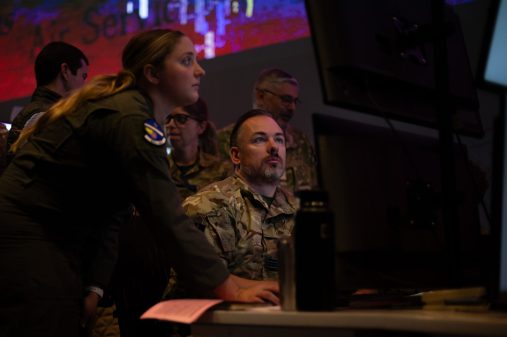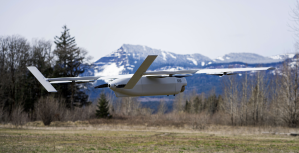Marines pursuing AI for sensor autonomy on multi-mission tactical drones

Officials are hoping to install new artificial intelligence tools on platforms for the Marine Air-Ground Task Force unmanned expeditionary (MUX) family of systems after the next increment comes along, according to a program director.
That includes technologies for the medium-altitude, long-endurance (MALE) drone — a role being filled by the General Atomics-built MQ-9A Reaper.
While the Reaper gained prominence as a terrorist hunter-killer for the Air Force and CIA during the post-9/11 wars in the Middle East, the Marine Corps primarily wants to use the system for communications and data network relay, electronic warfare, and maritime domain awareness missions in the Indo-Pacific region.
As part of its airborne network extension operational concept, the Corps envisions the MUX MALE system as a digitally interoperable “network bridge” and secure comms gateway for the Naval and joint force, according to slides presented by Lt. Col. Leigh Irwin at the Modern Day Marine conference on Thursday. That includes exchanging data with satellites, other drones and aircraft, ships, expeditionary advanced bases, maneuver forces on land, ground control stations and land-based sensors.
The concept fits in with the Pentagon’s Combined Joint All-Domain Command and Control initiative, which calls for better connecting sensors, platforms and data streams of the U.S. military and key allies under a more unified network.
Naval Air Systems Command’s program office for multi-mission tactical UAS, also known as PMA-266, sees AI as a key enabling technology for the future.
“We are at PMA-266 leaning forward a little bit ahead of our some of our NAVAIR peers in the artificial intelligence arena. We’re working with [the Pentagon’s Chief Digital and AI Office] to get essentially sensor autonomy is what we’re going after first. I think platform autonomy is definitely on the wish list, but I think it’s too far away for what we’re doing here. But sensor autonomy if we add cueing on the aircraft payloads, and then inherent sensors that come with MQ-9 Alpha so that the Marine on the ground doesn’t have to do all of that stuff — that’s a big one. So we’re aggressively pursuing that. I think it’s gonna take us a little longer than we expected because AI is hard. But we are pursuing some sensor abilities there,” Irwin, director of MUX/MALE programs, told DefenseScoop after her presentation.
“It’s more the algorithms and the ability to learn based on what it’s seeing and then — not make decisions — but inform the aircrew on what’s going on in the battlespace,” she added.
A key aim is to help reduce Marines’ workloads and make their operations more efficient and effective.
“It’s more cueing on what’s in the battlespace and us telling us, ‘Hey, this is what’s important to us.’ And so that sensor operator, maybe he gets an alert or he or she gets an alert when something’s important … rather than having to scan it and being like, ‘Oh, that’s important,’” Irwin explained.
Many unmanned aerial systems, such as the Reaper, are remotely piloted and currently require more manpower than the Marines would like to support their missions.
“Unmanned isn’t necessarily less labor intensive, I’ll say. I mean, you need almost as many Marines to fly an unmanned aircraft as you do a manned — and in some cases, more. So … any place where we can find a way to reduce the manpower it takes to do these missions and fly these aircraft, we’re looking at like [ground control stations] that can do more than one platform, AI that can help inform the operator of what’s going on so they don’t have to be staring at one screen the whole time and catch it themselves — things like that. Those are all types of things we’re looking at and hopefully to get to the future for MUX,” she said.
The Reapers that the Marines are getting for MUX MALE increment one are 36-feet long with a 66-foot wing span, have up to 27 hours of endurance, can fly at an altitude of 50,000 feet, have a payload capacity of 3,000 pounds external and 850 pounds internal, and can fly at a true air speed of 240 knots, according to Irwin’s slides.
Increment one will include 20 MQ-9A Block 5 systems plus associated ground control stations and Sky Tower data networking and comms relay pods. Twelve are currently fielded, according to her slides.
NAVAIR is also looking ahead at increment two.
“Our [initial operating capability] for increment two is going to be more in the 2026 time frame. I don’t expect [the AI-enabled sensor tools] to be ready then. I think it’ll be a couple or a few years after that, if I had to guess based on what we’re doing now. But we’re trying to get everything in place so that it can follow fairly quickly after we get the first piece of increment two,” Irwin said.
She told DefenseScoop that officials hope the technology will be ready for prime time before the end of the decade.






